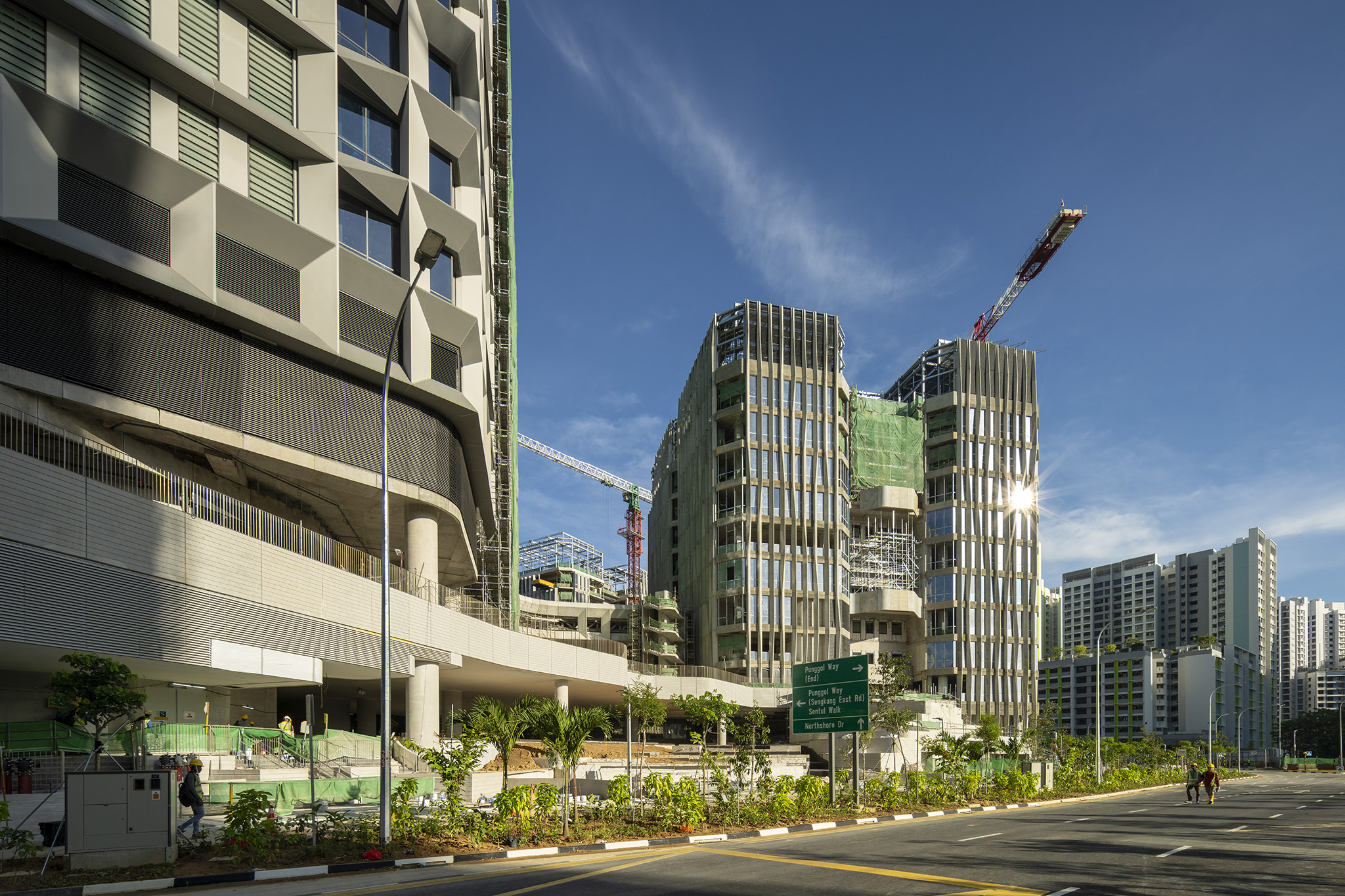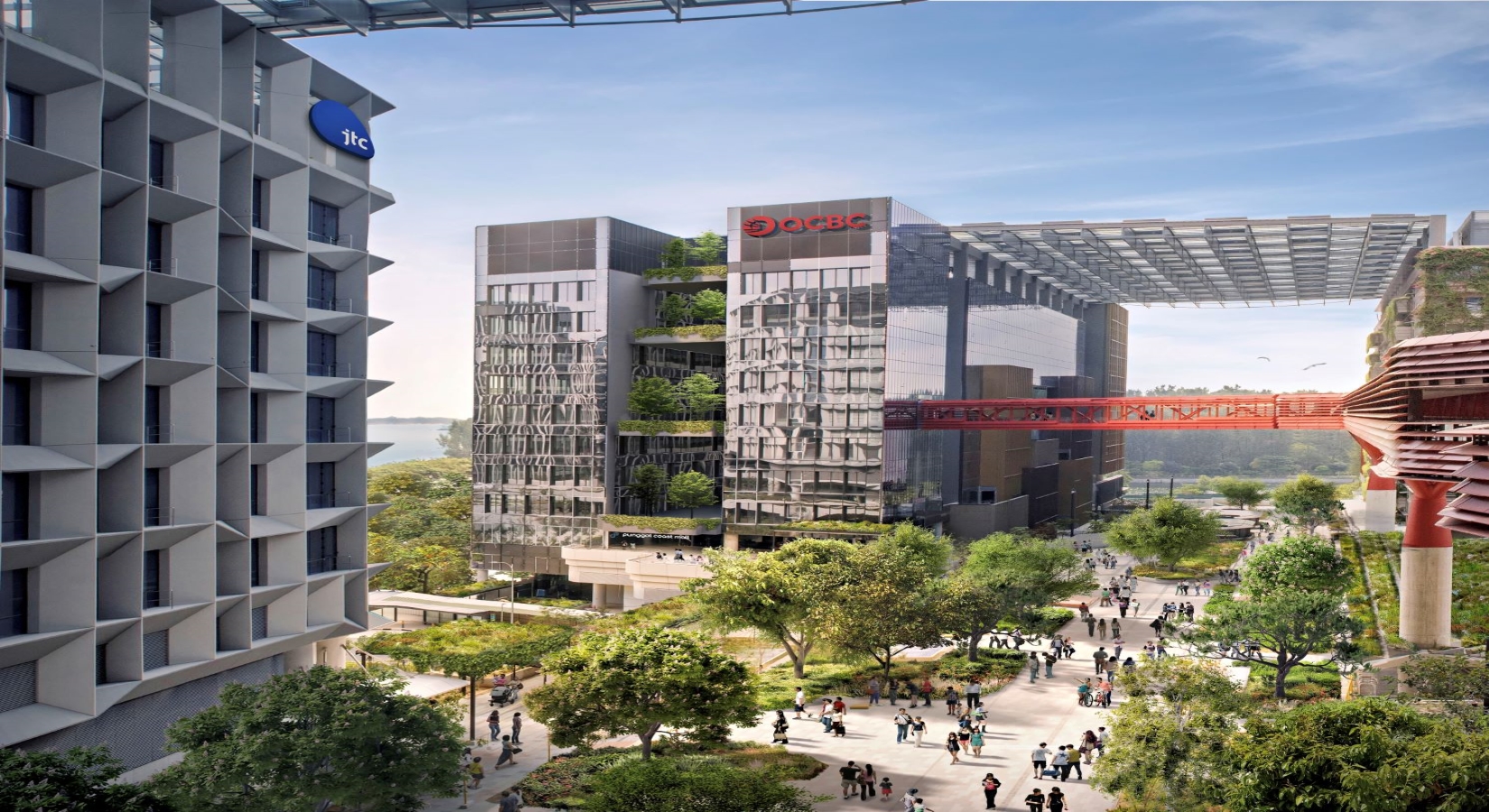
JTC today announced that Punggol Digital District has received the Building and Construction Authority’s Platinum Award for Green Mark Districts, which recognises the highest level of environmentally friendly and sustainable practices in the master planning, design and implementation of district developments.
Comprising JTC business park and the Singapore Institute of Technology (SIT) Punggol Campus, Punggol Digital District at 50 hectares is the largest mixed-use Green Mark Platinum District in Singapore, which employs at-scale sustainable practices in energy efficiency, water efficiency, material and waste management, environmental planning, green buildings and transport.
With integrated passive design strategies alongside advanced mechanical and electrical systems, the district will achieve 35% reduction in operational carbon emissions yearly, equivalent to taking 4,000 cars off the road.
Master planned and developed by JTC, the district is designed by WOHA Architects, and will bring 28,000 jobs, lifestyle and community amenities closer to homes. The SIT Punggol Campus, developed by SIT and designed together with WOHA Architects and RSP Architects Planners & Engineers, will be able to accommodate 12,000 students. The first phase of Punggol Digital District, which covers 21 hectares, will open progressively from 3Q 2024.
Green Buildings
The district’s buildings are benchmarked to the highest standards of sustainability, achieving Green Mark Platinum for 17 buildings developed by JTC and SIT. Active systems work in combination with passive design strategies to achieve thermal comfort and energy efficiency, including:
• North-south orientation to boost natural ventilation, with service spaces to buffer the east and west facades
• High performance facades with 30% reduction in heat gain and keeping the indoors cool
• Maximising natural daylighting with smart lighting controls
Super-low Energy certification
Additionally, Platinum Super-low Energy Certification was awarded for 3 buildings – JTC’s Mass Engineered Timber (MET) building, SIT’s MET Food Court and Multi-Purpose Hall. These best-in-class energy-efficient buildings will achieve at least 40% energy savings.
JTC’s eight-storey MET building is the tallest timber industrial building in Singapore. It achieves an outstanding embodied carbon performance of 15 kgCO2e/m2, which is 98% lower than BCA's benchmark (1,000 kgCO2e/m2) for non-residential buildings. Timber used for the building construction was sourced from sustainably managed forests, where new trees would be continuously planted to replace those that are harvested. Apart from being environmentally sustainable, the MET was fabricated off-site, providing better construction quality control and higher productivity with 60% reduction in on-site manpower, compared to traditional construction methods.
SIT’s Food Court adopts hybrid cooling and has a Building Integrated Photovoltaic (BIPV) roof that generates renewable energy. The Super-low Energy Food Court is also a showcase of energy efficiency and data driven automation in building operations, providing visitors with a comfortable dining experience optimised to the prevailing weather conditions.
The Multi-Purpose Hall adopts passive displacement ventilation for efficient cooling and uses high performance glass on the windows extensively to achieve high solar heat reduction.
Integrated Estate Infrastructure
Within the district, estate infrastructure is planned upfront to be centralised and integrated beyond the building-level for resource optimisation. Taking a layered masterplan approach, the infrastructure and services layer in the district is fully inter-connected underground, which also optimises land use.
Smart Grid
Across the district, solar photovoltaic (PV) panels are installed across multiple rooftops, producing over 3,000 megawatt-hours of clean energy annually, equivalent to the annual energy consumption of 11,000 three-room HDB flats.
The district will house Singapore’s first urban district-level smart grid, a living lab where companies can come and test their systems in an operational business park setting. Integrating solar energy with the smart grid enables peak shaving, a strategy for reducing the energy consumed during peak demand on the electrical grid, and ensures reliable and continuous energy supply to the district.
Punggol Digital District tenants and visitors can look forward to participating in the Singapore national electricity market through the onboarding of their electric vehicles, or in-house energy storage systems. Sanitised consumption data and profiles could be made available for the co-creation of other energy-related use cases, potentially supporting district-level energy demand reduction, gamification and sustainability initiatives. Such monitoring and potentially control of in-district energy assets can, with the support from the relevant authorities and upon successful pilot, be extended to interconnect and interact with neighbouring residential and SIT developments with their permission, for a district-wide demonstration.
SIT has also partnered with SP Group (SP) to build the first Multi-Energy Microgrid (MEMG) to be constructed on a university campus in Southeast Asia. It can integrate electricity from the national grid, renewable sources and energy storage in a unified smart energy network, to support applied learning and applied research.
District Cooling System
Punggol Digital District has interconnected district cooling plants with a combined cooling capacity of over 30,000 refrigeration tons, which improves energy efficiency through economies of scale. Built and operated by Engie, the DCS provides chilled water centrally to multiple users across all buildings in the district, including business park, office, retail, hotel/serviced residence, SIT Punggol Campus, transport facilities and community amenities. The underground plant serving JTC business park has a 4-kilometre underground pipe network, and is expected to reduce 3,700 tons of CO2 emissions per year at full development and achieve up to 30% reduction of energy consumption compared to standard commercial buildings.
Integrated Waste Management
An underground pneumatic waste conveyance system is implemented at Punggol Digital District to centralise waste collection, which minimises heavy vehicle traffic, noise, pests and odours associated with traditional waste collection. Chutes for recycling have also been implemented in the buildings. 100% of food and horticulture waste will be recycled into fertiliser using biodigestors, reducing over 3 tonnes of organic waste per day.
Data monitoring and analysis of the waste disposal and recycling patterns/volumes will also be carried out to optimise the deployment of resources needed for centralised waste collection and encourage people to reduce waste and recycle more.
Open Digital Platform
JTC has layered digital technologies and smart sensors onto integrated utilities for real-time data monitoring and additional efficiencies. Data-driven smart solutions will be used to monitor and manage energy and water use as well as reduce carbon emissions. Through integration with the Open Digital Platform, allowing communication and interaction with various systems in the district, such as the Smart Grid, DCS and the Building Management System, aspirations to push the boundaries for further energy savings of up to 20% may be achieved through artificial intelligence and machine learning.
Green Transport
To create a place that is car-lite and fully walkable, the district’s design departs from the usual city layout, with larger “super blocks” instead of regular “city blocks”. This means that the main roads are located at the edge of the district, while inside it, vehicular access roads, shared carparks and other service driveways are located fully underground. This makes the ground level completely open to public and friendly for walking and cycling.
A comprehensive network of transport infrastructure and facilities support greener mobility options. Punggol Digital District is commuter-centric and conveniently accessible with the upcoming Punggol Coast MRT station, bus interchange and new bus stops. The district has also made it easier for users to embrace a green lifestyle by providing over 1,500 bicycle parking lots and handy end-of-trip facilities like lockers and showers.
Shared carparking hubs enable the reduction of parking lots by 50% in this car-lite district. To support the transition to more sustainable vehicles, 96 electric vehicle charging lots will be available in the first phase, with electrical provisions built to ramp up to 151 lots in tandem with market demand.
Highly Liveable Landscapes
To create a highly liveable environment with regenerative landscapes, Punggol Digital District actively conserves the site’s natural assets by pedestrianising the existing old Punggol Road into a 1.3 kilometre tree-lined Heritage Trail. 4 hectares of the site’s vegetation is retained and transformed into an accessible community park that provides a generous breathing space with recreational nodes for people. The park supports numerous ecological networks within Punggol, serving as an area of refuge for local biodiversity and a green stepping stone for wildlife.
Across the district, space for nature is created together with floor area. The district achieves 100% landscape replacement, giving back in terms of urban greenery, biodiversity and ecosystem services such as reduction of urban heat island effect. This connects people with the natural world, which is essential for human well-being and psychological health.
Rooftop urban farms are also being prototyped in JTC business park for more extensive rollout in future phases, including a new urban typology of rooftop PV canopies integrated with urban farms. This offers an innovative solution towards achieving the national objectives of energy self-reliance and food resiliency in land scarce Singapore.
The district has implemented water sensitive urban design for water management, with bioswales, raingardens and rainwater harvesting to capture rainwater for reuse as non-potable water for landscape irrigation. Across the district, this would save 208,000 cubic metres of water annually, enough to fill 83 Olympic-size swimming pools. SIT was awarded ABC Waters Certified (Gold) for design excellence in integrating these ‘Active Beautiful Clean Waters’ design features.

Mr Nelson Liew, Group Director, New Estates, JTC, says, “PDD epitomises urban sustainability as the largest mixed-use Green Mark Platinum district, and exemplifies JTC's commitment to smart and sustainable industrial development. Seamlessly integrating built structures, energy efficiency, water conservation, waste management, mobility solutions, and green spaces, these sustainable features are intertwined on a district-wide scale through meticulous upfront planning, cultivating an estate that is not only highly liveable and environmentally sustainable, but also catering to the needs of those who work, live, play, and learn within and around the district. This integrated approach will set the stage for a truly vibrant and interconnected community, where innovation and sustainability thrive hand in hand, helping Singapore reach its net-zero goals and progress towards being a Smart Nation."
Mr Gerry Wee, Associate Vice President, Estates, SIT, says, “Sustainability lies at the core of our vision for the SIT Punggol Campus. Our commitment to environmental stewardship is evident in every aspect of our design, which is a testament to our dedication to a greener, more sustainable future. The SIT Punggol Campus has already achieved several accolades such as Green Mark Platinum with two Super Low Energy buildings and ABC Waters Certification (Gold) for its sustainable design features. With the campus designed as a Living Lab, SIT intends to further its sustainability efforts through education and research.

